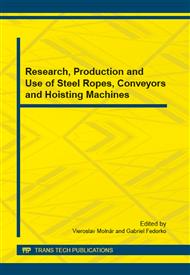p.183
p.189
p.196
p.202
p.208
p.213
p.219
p.225
p.232
Test Equipment for Analysis of Samples Rubber – Textile Conveyor Belts by Help Industrial Metrotomographs
Abstract:
The test equipment of samples for analysis of rubber-textile conveyor belts is a device designed to create tension and tracking the deformation in different cross sections of conveyor belts in one axis X. This construction is designed tensioning device, which allows the development of automatic tensioning force in one axis X-tensioning force F is exerted screw the nut with a torque wrench and a controlled strain-gauge sensor. Measured sample-textile conveyor belt is clamped in two adjustable clamping jaws ribbed belts for different thicknesses. Ribbed clamping jaws on one side of the tensioning device is attached to the frame and on the other hand are attached to the runner associated with the movable tensioning screw.
Info:
Periodical:
Pages:
208-212
Citation:
Online since:
October 2014
Authors:
Keywords:
Price:
Сopyright:
© 2014 Trans Tech Publications Ltd. All Rights Reserved
Share:
Citation:


